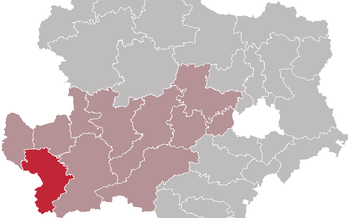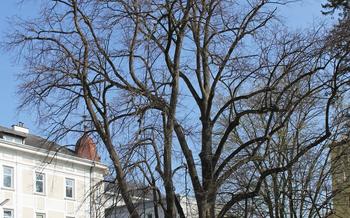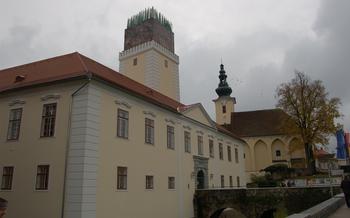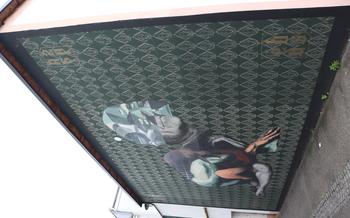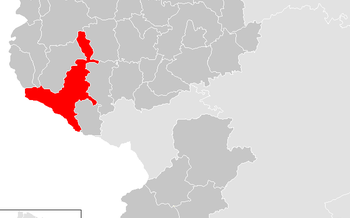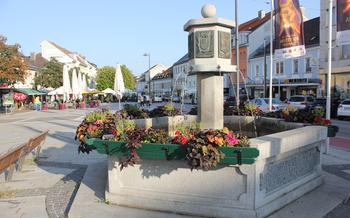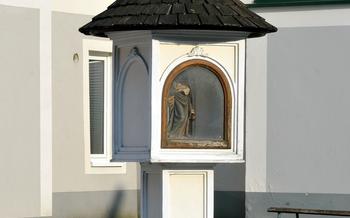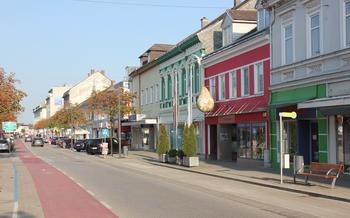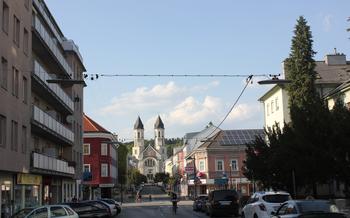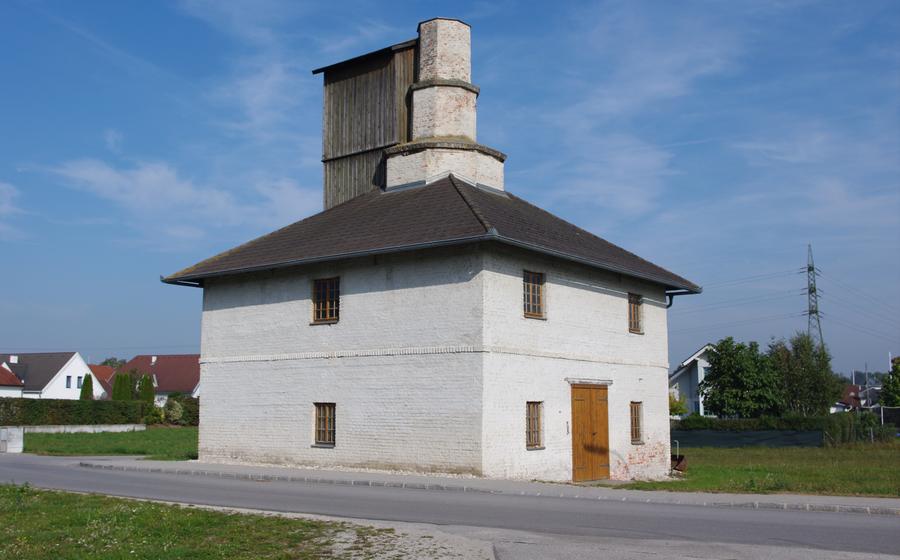
Brandstetter Hammer
- The Brandstetter Hammer
- History of the Brandstetter Hammer
- Industrial Heritage
- Architecture and Design
- Ironworking Process
- Interactive Exhibits:
- Guided Tours
- Museum Shop:
- Special Events
- Educational Programs:
- Accessibility:
- Hours of Operation and Admission Fees:
- Getting There:
- Insider Tip:
The Brandstetter Hammer
The Brandstetter Hammer, a remarkable relic of Austria's industrial past, stands as a testament to the region's rich ironworking heritage. Nestled in the picturesque town of Amstetten, Lower Austria, this imposing structure has borne witness to centuries of innovation and craftsmanship. Its enduring presence, coupled with its unique architectural features, makes it a captivating destination for history buffs, architecture enthusiasts, and anyone seeking a glimpse into the fascinating world of ironworking.
Located in the heart of Amstetten, the Brandstetter Hammer is easily accessible by car, public transportation, or foot. Its proximity to the Ybbs River, a crucial energy source for the hammer's operation, adds to its historical significance. As you approach this architectural marvel, its distinctive silhouette, dominated by the towering hammer wheel, hints at the remarkable feats of engineering that took place within its walls.
History of the Brandstetter Hammer
The origins of the Brandstetter Hammer can be traced back to the 16th century, when it was established as a water-powered ironworks along the banks of the Ybbs River. Initially, the hammer was used to produce wrought iron from local iron ore, playing a pivotal role in the development of the local ironworking industry.
Throughout the centuries, the Brandstetter Hammer underwent several technological advancements and expansions, reflecting the changing demands and innovations in the field of ironworking. In the late 18th century, the hammer was equipped with a new waterwheel and a larger forge, increasing its production capacity and efficiency.
During the Industrial Revolution, the Brandstetter Hammer embraced modern technologies, including steam power and mechanization. This transformation propelled the hammer to the forefront of industrial iron production, supplying high-quality iron products to various industries and contributing significantly to the region's economic growth.
Despite its industrial success, the Brandstetter Hammer faced challenges in the 20th century due to changing market conditions and competition from larger factories. In 1973, the hammer ceased its ironworking operations and was in danger of falling into disrepair.
Fortunately, a group of dedicated individuals recognized the historical and cultural significance of the Brandstetter Hammer and initiated efforts to preserve it. Through their tireless efforts, the hammer was restored to its former glory and transformed into a museum in 1989, showcasing the rich industrial heritage of Amstetten and its role in shaping the region's identity.
Industrial Heritage
Amstetten has a rich history of ironworking, with the Brandstetter Hammer playing a crucial role in the development of the local industry. Ironworking techniques evolved over time, with the hammer adopting more advanced technologies. During the industrial revolution, the Brandstetter Hammer stood as a symbol of innovation and progress, contributing significantly to Amstetten's industrial growth. Other industrial heritage sites in the region, such as the Anton-Mayer-Gedenkstätte and the Amstetten Museum, offer further insights into the city's industrial past.
Architecture and Design
The Brandstetter Hammer is a testament to the ingenuity and craftsmanship of its builders. Its sturdy structure is a blend of traditional and industrial styles, reflecting the transition from rural ironworking to large-scale production. Constructed primarily of wood and stone, the hammer features a striking combination of heavy timber beams and massive stone walls.
The main building, which houses the forge and the waterwheel, is a two-story structure with a gabled roof. The lower level is dominated by the forge, with its impressive hearth and anvil. The upper level, accessible by a wooden staircase, served as a storage area for iron ore and other materials.
The waterwheel, located at the rear of the building, is a marvel of engineering. Its massive wooden wheel, over 6 meters in diameter, is powered by the relentless flow of the Ybbs River. The wheel's rotation provides the energy needed to operate the forge's bellows and hammers.
Overall, the Brandstetter Hammer's architecture showcases the practical and functional nature of industrial buildings. Its simple yet robust design reflects the pragmatic approach of early industrialists, who prioritized functionality over ornamentation.
Ironworking Process
The ironworking process at the Brandstetter Hammer involved several intricate steps to transform iron ore into usable iron. Firstly, the iron ore was extracted from local mines and transported to the hammer. It was then crushed into smaller pieces and heated in a furnace to extract the iron. The molten iron was poured into molds to create cast iron products, such as tools, weapons, and household items.
The traditional methods used at the Brandstetter Hammer relied on skilled craftsmanship and the utilization of water power to operate the machinery. Blacksmiths and ironworkers played a crucial role in shaping the iron into various forms. The hammer's unique design allowed for precise and efficient forging, resulting in high-quality iron products.
Over time, technological advancements transformed the ironworking process. The introduction of new machinery and techniques, such as rolling mills and steam engines, increased productivity and efficiency. However, the Brandstetter Hammer remained a testament to the traditional methods and craftsmanship that had been passed down through generations.
Interactive Exhibits:
The Brandstetter Hammer features a range of interactive exhibits that bring the history of ironworking to life. These exhibits allow visitors to engage with the processes and techniques used in the past. Interactive touchscreens, multimedia presentations, and hands-on displays provide an immersive and educational experience. Visitors can learn about the different stages of iron production, from mining and smelting to forging and finishing. The exhibits also showcase the tools and equipment used by blacksmiths and ironworkers, offering a glimpse into the craftsmanship and skill required in this traditional industry.
For a truly hands-on experience, visitors can participate in the blacksmithing workshop. Under the guidance of experienced instructors, they can try their hand at forging iron using traditional tools and techniques. This unique opportunity allows visitors to experience the physical and creative aspects of ironworking, creating a lasting memory of their visit to the Brandstetter Hammer.
Guided Tours
Guided tours of the Brandstetter Hammer offer a deeper dive into the history, technology, and cultural significance of this industrial heritage site. Knowledgeable guides lead visitors through the various sections of the hammer, providing insights into the ironworking process, the role of water power, and the lives of the workers who operated the machinery.
Tours typically last for about an hour and cover topics such as the origins and development of the Brandstetter Hammer, the different types of ironworking tools and techniques used, and the importance of the hammer in the local economy. Visitors can also learn about the challenges faced by the ironworkers, the impact of industrialization on the region, and the efforts made to preserve this unique industrial heritage site.
Taking a guided tour is highly recommended for those who want to gain a comprehensive understanding of the Brandstetter Hammer and its significance. Tours are available in German and English, and reservations are recommended to ensure a spot. Visitors can book tours online or by calling the museum directly.
Museum Shop:
The Brandstetter Hammer boasts a well-stocked museum shop where visitors can purchase a variety of souvenirs and merchandise to commemorate their visit. These include books, postcards, and replicas of historical artifacts related to the hammer and its operations. Visitors can also find unique items such as handcrafted ironwork, pottery, and textiles inspired by the region's rich industrial heritage. By supporting the museum through purchases, visitors contribute to the preservation and promotion of this important cultural site.
Special Events
The Brandstetter Hammer regularly hosts a variety of special events that celebrate its history, industrial heritage, and the art of ironworking. These events offer visitors a chance to experience the museum in a unique and engaging way.
Ironworking Demonstrations: Immerse yourself in the fascinating process of ironworking through live demonstrations by skilled blacksmiths. Watch as they transform molten iron into beautiful and functional objects, using traditional techniques passed down through generations.
Historical Reenactments: Step back in time and witness historical reenactments that bring the Brandstetter Hammer's past to life. Actors in period costumes showcase the daily operations of the hammer, demonstrating the roles of blacksmiths, apprentices, and other workers.
Cultural Festivals: Throughout the year, the museum hosts cultural festivals that celebrate the region's rich traditions and heritage. These festivals feature traditional music, dance, food, and crafts, providing visitors with a glimpse into the local culture.
Educational Workshops: Participate in hands-on workshops that offer a deeper understanding of ironworking and its significance. Learn how to forge your own iron objects, such as knives, nails, or decorative pieces, under the guidance of experienced instructors.
Summer Concerts: During the summer months, the Brandstetter Hammer transforms into a concert venue, hosting live music performances amidst the picturesque surroundings of the museum grounds. Enjoy an evening of music, dance, and food while immersing yourself in the beauty of this historical site.
Educational Programs:
The Brandstetter Hammer offers a range of educational programs tailored for schools and groups of all ages. These programs provide an immersive and interactive learning experience, allowing students to delve into the history, technology, and cultural significance of ironworking.
The programs are designed to complement school curricula, covering topics such as industrial heritage, the Industrial Revolution, and the importance of skilled craftsmanship. Through hands-on activities, demonstrations, and guided tours, students gain a deeper understanding of the processes involved in transforming iron ore into usable iron.
For younger students, the focus is on exploration and discovery, with activities that encourage them to engage with the exhibits and learn about the history of the hammer in a fun and engaging way. Older students can participate in more in-depth programs that delve into the scientific and technological aspects of ironworking.
The Brandstetter Hammer's educational programs provide a valuable opportunity for students to connect with their local history and heritage while gaining a deeper appreciation for the ingenuity and craftsmanship that shaped the industrial world.
Accessibility:
The Brandstetter Hammer is committed to providing an inclusive and accessible experience for all visitors. Accessible features include wheelchair ramps, elevators, and designated parking spaces for disabled visitors. Audio guides and sign language interpretation are also available upon request. The museum staff is trained to assist visitors with disabilities and ensure they have a comfortable and enjoyable visit. Additionally, the interactive exhibits are designed to be accessible and engaging for visitors of all abilities.
Hours of Operation and Admission Fees:
The Brandstetter Hammer is open to the public from Tuesday to Sunday, with varying hours depending on the season. During the summer months (April to October), it operates from 9:00 AM to 5:00 PM, while in the winter months (November to March), the hours are 10:00 AM to 4:00 PM. The museum is closed on Mondays and public holidays.
Regular admission fees apply for all visitors, with discounts offered to seniors, students, and groups. Families can also avail of special rates. The museum offers online ticketing and reservations for a hassle-free experience, allowing visitors to plan their visit in advance.
Getting There:
Reaching the Brandstetter Hammer is a breeze, whether you opt for a scenic drive, a convenient public transport ride, or an invigorating stroll.
-
By Car: Embark on a leisurely road trip along the well-marked routes leading to Amstetten. Ample parking spaces await your arrival, ensuring a hassle-free visit.
-
By Public Transportation: Hop on a train to Amstetten station and immerse yourself in the charm of this historic town. From there, a short bus ride or a pleasant 15-minute walk will bring you to the doorstep of the Brandstetter Hammer.
-
On Foot: Lace up your walking shoes and embark on a picturesque journey through Amstetten's enchanting streets. As you approach the Ybbs River, keep your eyes peeled for the iconic silhouette of the hammer, beckoning you to explore its fascinating history.
Insider Tip:
-
For an unforgettable experience, plan your visit to the Brandstetter Hammer during the annual Iron Hammer Festival held in July. Immerse yourself in the sights, sounds, and aromas of traditional ironworking demonstrations, live music, and local delicacies.
-
Extend your journey by exploring the charming town of Amstetten, known for its vibrant arts scene, picturesque parks, and historical landmarks. Stroll along the scenic Ybbs River, visit the Amstetten Art Gallery, and indulge in the local cuisine at one of the many traditional restaurants.
-
Capture the essence of the Brandstetter Hammer's industrial heritage through photography. The unique textures, weathered surfaces, and intricate details of the machinery make for captivating subjects. Experiment with different angles and perspectives to create striking compositions.
